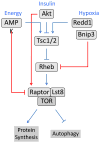TOR-dependent control of autophagy: biting the hand that feeds
- PMID: 20006481
- PMCID: PMC2854204
- DOI: 10.1016/j.ceb.2009.11.005
TOR-dependent control of autophagy: biting the hand that feeds
Abstract
Induction of autophagy in response to starvation is a highly conserved ability of eukaryotic cells, indicating a crucial and ancient role of this process in adapting to nutrient conditions. The target of rapamycin (TOR) pathway is major conduit for such signals, and in most cell types TOR activity is necessary and sufficient to suppress autophagy under favorable growth conditions. Recent studies have begun to reveal how TOR activity is regulated in response to nutritional cues, and are shedding new light on the mechanisms by which TOR controls the autophagic machinery. In addition, a variety of signals, stressors and pharmacological agents that induce autophagy independent of nutrient conditions have been identified. In some cases these signals appear to have been spliced into the core TOR pathway, whereas others are able to bypass the control mechanisms regulated by TOR. Increasing evidence is pointing to an important role for both positive and negative feedback loops in controlling this pathway, leading to an emerging view that TOR signaling not only regulates autophagy but is also highly sensitive to cellular rates of autophagy and other TOR-dependent processes.
Copyright 2009 Elsevier Ltd. All rights reserved.
Figures


Similar articles
-
mTOR regulation of autophagy.FEBS Lett. 2010 Apr 2;584(7):1287-95. doi: 10.1016/j.febslet.2010.01.017. Epub 2010 Jan 18. FEBS Lett. 2010. PMID: 20083114 Free PMC article. Review.
-
Direct induction of autophagy by Atg1 inhibits cell growth and induces apoptotic cell death.Curr Biol. 2007 Jan 9;17(1):1-11. doi: 10.1016/j.cub.2006.10.053. Curr Biol. 2007. PMID: 17208179 Free PMC article.
-
The Tor and PKA signaling pathways independently target the Atg1/Atg13 protein kinase complex to control autophagy.Proc Natl Acad Sci U S A. 2009 Oct 6;106(40):17049-54. doi: 10.1073/pnas.0903316106. Epub 2009 Sep 21. Proc Natl Acad Sci U S A. 2009. PMID: 19805182 Free PMC article.
-
TOR Signaling and Nutrient Sensing.Annu Rev Plant Biol. 2016 Apr 29;67:261-85. doi: 10.1146/annurev-arplant-043014-114648. Epub 2016 Feb 22. Annu Rev Plant Biol. 2016. PMID: 26905651 Review.
-
With TOR, less is more: a key role for the conserved nutrient-sensing TOR pathway in aging.Cell Metab. 2010 Jun 9;11(6):453-65. doi: 10.1016/j.cmet.2010.05.001. Cell Metab. 2010. PMID: 20519118 Free PMC article. Review.
Cited by
-
Che-1-induced inhibition of mTOR pathway enables stress-induced autophagy.EMBO J. 2015 May 5;34(9):1214-30. doi: 10.15252/embj.201489920. Epub 2015 Mar 14. EMBO J. 2015. PMID: 25770584 Free PMC article.
-
Hygromycin B hypersensitive (hhy) mutants implicate an intact trans-Golgi and late endosome interface in efficient Tor1 vacuolar localization and TORC1 function.Curr Genet. 2017 Jun;63(3):531-551. doi: 10.1007/s00294-016-0660-9. Epub 2016 Nov 3. Curr Genet. 2017. PMID: 27812735 Free PMC article.
-
Molecular Mechanism of Overcoming Host Resistance by the Target of Rapamycin Gene in Leptographium qinlingensis.Microorganisms. 2022 Feb 24;10(3):503. doi: 10.3390/microorganisms10030503. Microorganisms. 2022. PMID: 35336079 Free PMC article.
-
Molecular regulation and therapeutic implications of cell death in pulmonary hypertension.Cell Death Discov. 2023 Jul 12;9(1):239. doi: 10.1038/s41420-023-01535-6. Cell Death Discov. 2023. PMID: 37438344 Free PMC article. Review.
-
Role of the USP family in autophagy regulation and cancer progression.Apoptosis. 2025 Jun;30(5-6):1133-1151. doi: 10.1007/s10495-025-02095-z. Epub 2025 Mar 5. Apoptosis. 2025. PMID: 40042743 Review.
References
-
- Bhaskar PT, Hay N. The two TORCs and Akt. Dev Cell. 2007;12:487–502. - PubMed
-
- Smith EM, Finn SG, Tee AR, Browne GJ, Proud CG. The tuberous sclerosis protein TSC2 is not required for the regulation of the mammalian target of rapamycin by amino acids and certain cellular stresses. J Biol Chem. 2005;280:18717–18727. - PubMed
Publication types
MeSH terms
Substances
Grants and funding
LinkOut - more resources
Full Text Sources
Other Literature Sources

